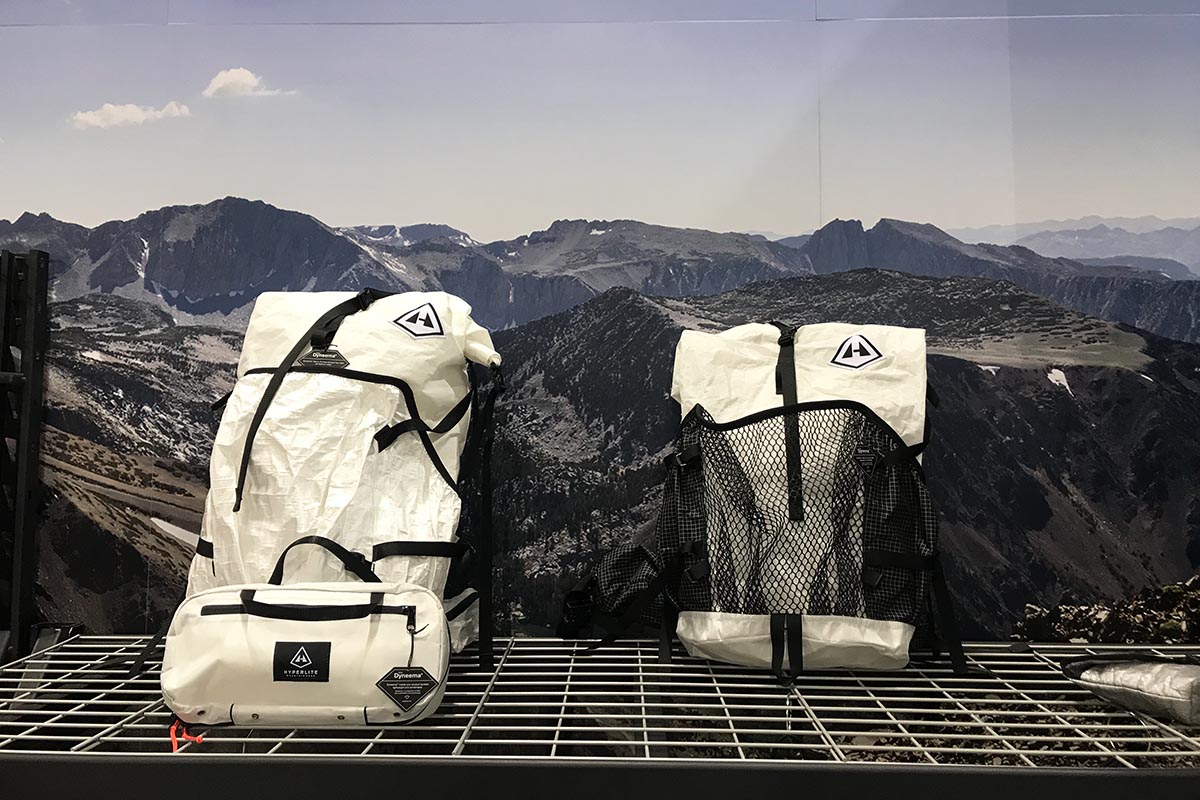

Switchback Travel


Switchback Travel
From June 18-20, Outdoor Retailer hosted its Summer Market in Denver, Colorado: a trade show where manufacturers showcase new products and future releases. The show floor was lined with booths from many of the major brands, including Patagonia, Salomon, Nemo, Big Agnes, and more. We had a chance to check out what’s new in the world of camping, hiking, and running, and below we break down some of our favorite products from the show, as well as overall trends that we’re seeing in the outdoor industry.
Patagonia’s Torrentshell has been a leading rain jacket in the company’s lineup for years: it’s lightweight, packable, and offers reliable weather protection in moderate conditions. However, as with many 2.5-layer designs, we found that the Torrentshell isn’t a great breather and can get overwhelmed in a deluge. Patagonia is addressing these concerns head-on with the introduction of a new 3-layer design for February 2020. Simply put, the latest jacket should see a notable bump in overall weather protection, breathability, and durability..jpg)
MSR is well-established in the backpacking world, but they’re about to enter the family camping category in a major way. The Habitude (available in 4-person and 6-person models) is designed with kids in mind, sporting family-friendly features like a standing-height interior, plenty of gear storage, oversized doors, and even an integrated porch light. We’ve tested many MSR tents over the years—including the Hubba Hubba NX, Access, and Remote series—and have been consistently impressed by the company’s attention to detail and high-quality, durable designs. At 12 pounds for the 4P version, you won’t be hauling the new Habitude along on any backcountry adventures, but we think it’s a great option for growing families. Expect to see the tent hit stores in February 2020—the 4P will retail for $500 and the 6P for $600.
Another standout product from MSR debuted at the Summer Market was their Thru Link In-Line Microfilter. Unlike other backpacking filters that require a lot of effort—like laying on the ground, pumping, or filling up and squeezing your water bottles—the Thru Link attaches directly to your hydration reservoir and does the work for you. To use, simply fill your reservoir and attach the filter directly between the hose and bladder. Unfortunately, bottle users will have to look elsewhere, but those who use hydration reservoirs will likely find Thru-Link to be a great addition to their backcountry kit: it’s lightweight (2.5 ounces), affordably priced ($40), and easy to use with no moving parts. The filter is expected to hit the market in February 2020.
Meant to bridge the gap between Nemo’s popular Dagger and ultralight Dragonfly, the Firefly is the company’s latest addition to their impressive lineup of backpacking tents. At 3 pounds, the 2P model undercuts the Dagger by 5 ounces and outweighs the Dragonfly by 6. Additional highlights include a freestanding build, rainfly that connects directly to the pole structure for greater weather-worthiness, and Nemo’s well-loved, generously sized vestibules. Nemo is also releasing the Aurora in 2020, which will replace the Galaxi as the company’s entry-level backpacking model—we like that it will be affordably priced at $250, feature truly vertical walls, and come with a footprint..jpg)
We commonly see backpacking tents sacrifice livability to shave weight, but that’s not the case with Big Agnes’ new Salt Creek SL 2. At 3 pounds 14 ounces, it stacks up competitively to popular lightweight designs like Nemo’s Dagger 2P (3 pounds 5 ounces) and MSR’s Hubba Hubba NX (3 pounds 8 ounces), while undercutting many hybrid/car camping options like Marmot’s Tungsten 2P (4 pounds 13 ounces) and REI’s Half Dome 2 Plus (4 pounds 14 ounces). But the biggest news about the Salt Creek is its doors: the two-person model has three of them, one of which can be propped up with hiking poles to form an awning along the side of the tent. We often complain that two-person tents can feel cramped with a tent mate, but Big Agnes’ new system opens up the interior in a big way (weather permitting)..jpg)
Lowa’s Renegade is the brand’s signature boot, but we think they’re making big strides with the new-for-2020 Explorer. With a clear focus on getting faster and lighter, the Explorer—available in mid-height and low-top versions—is essentially a traditional hiking boot with weight-conscious features like a lighter midsole and thin toe cap. The boot will be available in both Gore-Tex and non-Gore-Tex versions.
Maine-based Hyperlite Mountain Gear has led the charge in the use of Dyneema Composite Fabrics (DCF), which is among the strongest materials in the world, extremely lightweight, and highly water-resistant. New for this summer, the company has expanded its line of DCF packs with the introduction of the Junction: a model meant to bridge the gap between the company’s Windrider and Southwest collections. In testing both the 2400 Southwest and 3400 Windrider, we were impressed by the packs’ low weight, weatherproofing, and overall durability. The Junction is identical in weight to the Southwest at 2 pounds for the 3400, but adopts features from both models, including the Windrider’s front mesh panel and the Southwest’s solid Dyneema side pockets. The Junction comes in 2400 (40 liters; $310) and 3400 (55 liters; $345) capacities and is now available exclusively through Hyperlite Mountain Gear’s website.
Adding to its collection of jackets that use the company’s in-house AscentShell waterproofing, the Outdoor Research MicroGravity is designed to blur the line between hardshell and softshell. By incorporating polyester into the jacket’s face fabric, the 3-layer MicroGravity will likely perform similarly to the company’s popular Interstellar Jacket (see our in-depth review here), but with added freedom of movement for activities like climbing and biking. OR also claims the MicroGravity will be more breathable and waterproof than the Interstellar, so we’re eager to see how it stacks up when it’s released in spring 2020..jpg)
There has never been a universal method for testing a sleeping pad’s warmth, which is measured in R-value. Instead, sleeping pad manufacturers have typically developed their own way of testing or simply displayed a temperature rating for their pads. However, throughout the past few years, there has been a push to standardize sleeping pad ratings, encouraging gear companies to get on board. The big news from the Summer Market: two of the biggest names in the backpacking business, Big Agnes and Nemo, will now display R-value for all of their sleeping pads. What does this mean for you? In short, you will soon be able to more confidently determine how warm a sleeping pad is and more easily compare pads from different brands.
Down and synthetic insulation have distinctly different properties and strong suits, so it comes as little surprise that hybrid jackets are becoming increasingly popular. To summarize: down is incredibly warm, lightweight, and packable, but it doesn’t retain its loft or insulating ability when wet. On the other hand, synthetic insulation is less compressible and heavier than down, but is more breathable and doesn’t soak up water in light to moderate precipitation.
One company at the forefront of this “hybrid” revolution was Arc’teryx. By using what they call “Down Composite Mapping” in their Cerium collection, the company combined Coreloft synthetic insulation in moisture-prone areas with premium down in places that need the heat (like the core, hood, and upper arms). At the Outdoor Retailer Summer Market, Rab’s latest addition, the Kaon Jacket, stood out the most in this hybrid category. By mixing 800-fill-power goose down along the center of the jacket with synthetic Stratus insulation along the shoulders, cuffs, and hips, the Kaon utilizes what Rab calls “intelligent zoning” to blend the weather resistance of synthetic with the insulating properties of down. Given our experience testing Arc’teryx’s Cerium LT and SL hoodies, we have high hopes for the Rab jacket (coming spring 2020).
Hiking footwear has been moving away from bulky boots toward lightweight shoes and trail runners for years, and we’re seeing more and more of a crossover between the categories. At the Summer Market, Scarpa debuted their Rush: a trail runner/lightweight hiker that’s designed for fast-and-light missions or high-mileage runs. At 1 pound 10.8 ounces per pair, the Rush’s weight clearly reflects its hybrid build: it will undercut much of the hiking shoe competition, but most true trail runners come in a few ounces lighter. La Sportiva also showcased its Sabre GTX, a mid-height hiking boot that draws heavily from the company’s trail-running expertise. And Oboz’s new-for-2020 Arete, which will undercut their popular low-riding Cirque, also takes cues from trail runners with its rugged rubber outsole and lightweight build..jpg)
Sustainability has been an ever-growing focus within the outdoor industry for years, but a few brands are making tangible strides toward measuring and communicating their efforts. Marmot, in particular, is incorporating big changes into their line. Following the newly released PreCip Eco rain jacket (which now uses all recycled materials), Marmot is soon introducing a rating system that will be displayed on all its products. Starting in spring 2020, the company’s outerwear and sleeping bags will display a “good,” “better,” or “best” rating tag depending on their use of recycled materials, PFC-free compliance (a chemical often used in the production of water-repellent coatings), and overall use of harmful chemicals. Marmot plans to expand this throughout its entire line beginning next fall.
Tecnica recently announced the debut of their Origin, a heat-moldable trail-running shoe that’s custom-fitted to each runner’s foot. At the Summer Market, we also sat down with Salomon, who is introducing a similar concept in their Cross /Pro trail runner. In spring 2020, Salomon plans to bring its ME:sh program to the U.S. (currently, it’s only available in Europe), which will allow runners to visit specific retailers across the country and achieve a similar customized fit. We’re very interested to see how individualized shoes will affect the trail-running and hiking footwear markets, and how these will stack up against the current top performers.
We’re seeing more and more companies incorporate stretch into their hardshells and rain jackets, and we think it’s a great direction. For example, we recently tested Patagonia’s 2.5-layer Stretch Rainshadow in the Grand Canyon and came away impressed: the nylon in the face fabric gave the jacket noticeably more elasticity, comfort, and freedom of movement for activities like climbing and biking (read our in-depth review here). At Outdoor Retailer, a few newcomers followed suit, including Black Diamond’s new Highline Stretch Shell, Outdoor Research’s MicroGravity Jacket, and Marmot’s Keele Peak Jacket. We’re eager to see how these new hardshell jackets stack up to the competition when they debut next year.